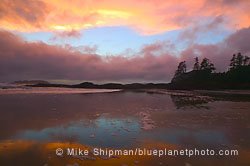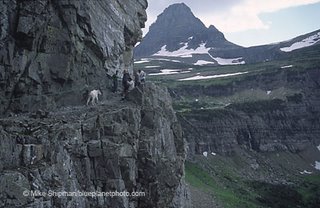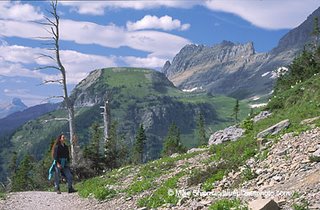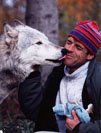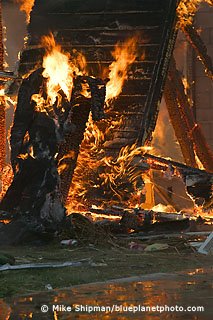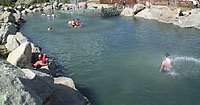Today I should be doing other things, but for some reason I can't be bothered. Projects to do and I'm just not motivated. Plus, Blogger has been down all day so I couldn't vent. So, I found something more productive to do.
Today, apparently, is a day of discovery (or the announcement of discoveries) and I have four stories here for your enjoyment.
Back From the DeadNew Salamander Fossil Gets TossedExtraterrestrial LifePrudhoe Bay Oil Spill
Back from the DeadThis is about a once-thought-to-be-extinct rodent turning up for sale in a meat market in Laos. First off, I think someone finally figured out that instead of traipsing through the woods looking for stuff, you should just go down to the local market and check out what's on the menu. My guess, it was a lazy grad student or field assistant who couldn't handle traipsing about in the jungle that first came up with this search "methodolgy". It sure is smart, though. I remember from my old Gerald Durrell books when they were out collecting animals for zoos they wouldn't go out and capture the animals themselves, usuall. They would rent out the nicest villa in the area, or shack up with the king, and let the locals do the dirty work. They knew where the animals were, anyway. How long do you think it would have taken this team from one of the British Isles on there own find the animals on their grocery list?
Once in a while, Gerald and his team would chase an anteater or wrestle a caiman, but most of the stories revolved around the antics of the animals already caught and the tribulations of housing and transporting them. This was back in the 1950s if I remember correctly. So, they knew the most efficient way to get what they needed. Maybe this grad student or lazy field assistant read some of Gerald Durrell's books, too. Searching for new species in a market is a pretty good idea for the same reason, especially in areas of the world where folks eat a pretty wide variety of animals, plants, insects, sea life, and other goodies. Turns out, the locals have known about this little critter for quite a while and even have a name for it, Kha-Nyou.
Anyway, this new species of rodent, a member of the previously known rodent family Diatomyidae, tentatively named Laonastes aenigmamus, was thought to have gone extinct 11 million years ago. These discoveries of previously-thought-extinct animals has even been given a name, the "Lazarus Effect". The Coelocanth is the best example, pulled up in a net off the shores of South Africa back in the 1980s.
What's funny about this story is that one team of folks from the Wildlife Conservation Service actually found it first, but thought it was a new species.
News Story, then another team who examined it more closely later discovered similarities with the fossil record and made the connection
News Story.
Here's a sketch of the critter:
 Back From the DeadNew Salamander Fossil Gets TossedExtraterrestrial LifePrudhoe Bay Oil SpillNew Salamander Fossil Gets Tossed
Back From the DeadNew Salamander Fossil Gets TossedExtraterrestrial LifePrudhoe Bay Oil SpillNew Salamander Fossil Gets TossedHere's a story about why you should stay in school. Picture this...you're in college, a geology student and a Freshman to boot, cooped up in class for days, weeks even. Then you get to go outside on a field trip. A Field Trip! No class! A ritual that used to be reserved for kindergarten and elementary students that has, sadly, also gone the way of the dinosaurs. That was why I went to college, to go on field trips. I missed them in Jr. High and High School. So, here's this freshman out on the field trip. A geology field trip, so they're obviously looking for rocks or some earthly-oriented materials or features. He's strolling along in a new road cut where buylldozers have scraped away part of a hillside.

He spots something interesting and picks it up.
Nope, not interesting after all. And he tosses it back to the ground.
(can you see the teeth?)
Well, on his walk, looking for something interesting, he discovers nothing. Remembering that silly rock he picks it up on the way back to the bus and shows it to his professor who instantly sees the teeth then the outline of the skull and recognizes it as significant.
That's why professors get the big bucks and Freshman still have at least 3 years to go before graduating.
Turns out, this is the fossil head of a new salamander species (
News Story) that lived, oh, 300 million years ago.
Now, when a new species is found the person who finds it is somehow honored by either having part of their name included in the binomial (species name, typically) or their last name is added at the end in parentheses, i.e. Genus species (finder). So who do you think really "discovered" this fossil? Sure, the Frosh picked it up, tossed it away (luckily not into the nearest pond or river) then retrieved it again because he couldn't find anything better. But it was the professor who recognized it for what it was. I think he should have a piece of it as well.
Back From the DeadNew Salamander Fossil Gets TossedExtraterrestrial LifePrudhoe Bay Oil SpillExtraterrestrial LifeThere is a race on, I believe, to be the first person, team, company, agency, country, etc. to find life outside our tiny planet. Mars hasn't seemed to pay up like it was promised a few months ago. But then it will probably be years before any discoveries of that sort are revealed, primarily because we'll need to bring back specimens for analysis to be really sure. There's hope yet.
Now we've moved on to Saturn, as if Mars wasn't far enough from the sun. Enceladus,
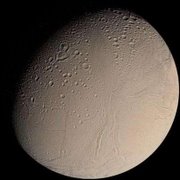
one of Saturn's small moons, is gushing out water vapor, a possible sign that life could exist since liquid water is a key element for life (as we know it) to exist. Geothermal activity below the moon's surface could harbor life not dependent upon sunlight as is evidenced by deep ocean life existing here on Earth that thrive in total darkness and are sulfur-based life forms rather than carbon-based.
The plume of water, coming out of the south pole region of Enceladus, is half the size of the moon itself. This suggests a very large explosion and high pressure. What that might be doing to any lifeforms, however small, in that region is anyone's guess. We might be witnessing a mass extinction event.
News StoryBack From the DeadNew Salamander Fossil Gets TossedExtraterrestrial LifePrudhoe Bay Oil SpillPrudhoe Bay Oil SpillUp to 267,000 gallons of oil spilled out of the Alaska Pipeline at Prudhoe Bay, Alaska. The spill was discovered on March 2 and was reported March 10. About 2 acres (1.9) of tundra was affected. BP shut down operations in that area, suffering a loss of 100,000 barrels per day of oil production. Clean up of the spill is expected to take four to six weeks (
News Story).
This is the largest spill so far on the North Slope. I don't know how many other spills have occurred over the years. The environmental effect is cumulative, regardless. I haven't been to Prudhoe Bay, but I have worked in areas where mining is and has taken place. I can say from first hand experience there that the land is altered. Restoration of the landscape is required when extraction activities cease and some restored areas enjoy better success than others. That's down here in the lower 48 where growing seasons are long.
The North Shore is a different story. Think of a 14,000 ft mountain peak. Like the saying goes, "what happens here stays here". The effects of oil spills and pollution in the arctic tundra will remain for years to come. While this spill is relatively small, and occurred in an area most likely already heavily impacted by oil processing activities, it goes to show that extractive industries are not foolproof.
I'm not hypocritical. I know that many, many products we depend on come from petroleum-based compounds, not just fuel. Most synthetic fabrics, plastics, food products, and a host of others. Most folks think we shouldn't drill in the Arctic National Wildlife Refuge (ANWR) and they're probably right. It's a war of resources, really. One has a measurable economic value, the other basically immeasurable but devalued due to lack of access (economic measure of tourism value, for example) or lack of understanding of it's role in the operation of life support on our planet.
Much thinking about the land and environment still practiced today, a holdover from the early days, is more utilitarian. If it can't be used in some way it's not valuable. An empty patch of land has no value unless there's a house or office complex or parking lot on it or that you can hunt or fish or boat on it. A patch of land in this view has no intrinsic value, which is to say a value that can be calculated as well as no value calculable. How do you value a stand of trees producing oxygen, scrubbing the air of pollutants generated down the road? Or that same stand of trees as a place to rest and relax by yourself or with friends?
My point is that we do need to extract resources from the Earth. However, we need to find the most efficient, least intrusive, and sustainable methodologies to do that so we aren't required to poke, prod, dig, cut, blow up, mash, compact, and alter every scrap of non-asphalt remaining. I've seen both sides of the fence, worked both sides of the fence, and I can tell you there are problems everywhere. The grass is no greener on one side than on the other. It's all a matter of perception. Hardliners at both ends make it very difficult to come to a reasonable solution. I was one, once. It makes life a little easier when you only have one goal. But life isn't that simple. There has to be some give and take, within reason. I will always be on the side of the environment because it's the only one we have and I do understand that without it we will perish, physically and mentally and culturally.
That's enough for now.
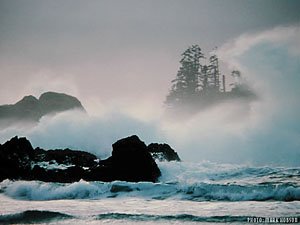
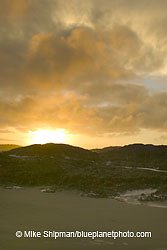 Vancouver Island
Vancouver Island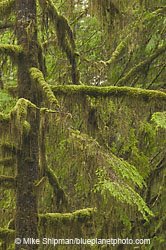 Road Trip
Road Trip